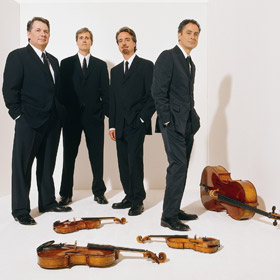By Stephen Brookes • The Washington Post • October 16, 2011
The Emerson String Quartet is one of the world’s blue-chip chamber groups, so perhaps it wasn’t a surprise that it turned in a superb and often deeply involving performance on Saturday night at the National Museum of Natural History’s Baird Auditorium. What was a little surprising was the relative conservatism of the program — a well-worn path of late works by Mozart and Beethoven — but as it turned out, the conservatism was only skin deep. Playing in their trademark standing positions, the Emersons opened with Mozart’s Adagio and Fugue in C Minor K. 546. Stately and rather formal, it’s not a particularly “Mozartean” piece, and the ensemble didn’t reveal any unexpected beauties in it — though the Fugue, which started with worrying slackness, built to a brilliant and furious close. It was with the composer’s Quartet in D, K. 575, though, that the Emersons displayed the insightful and absolutely crystalline playing that is their hallmark. Everything that you come to Mozart for — the profound logic that integrates every note, the delicate and closely observed emotions, the sly glimpses of the sublime — was there; and though this was not exactly a risk-taking or passionate performance, it shone with intelligence and wit.
Playing in their trademark standing positions, the Emersons opened with Mozart’s Adagio and Fugue in C Minor K. 546. Stately and rather formal, it’s not a particularly “Mozartean” piece, and the ensemble didn’t reveal any unexpected beauties in it — though the Fugue, which started with worrying slackness, built to a brilliant and furious close. It was with the composer’s Quartet in D, K. 575, though, that the Emersons displayed the insightful and absolutely crystalline playing that is their hallmark. Everything that you come to Mozart for — the profound logic that integrates every note, the delicate and closely observed emotions, the sly glimpses of the sublime — was there; and though this was not exactly a risk-taking or passionate performance, it shone with intelligence and wit.
But the real reward came in the second half of the program, which was devoted to Beethoven’s monumental Quartet in B-flat, Op.130, and the Grosse Fuge, Op. 133. And devoted is the word. It’s rare to hear such committed playing from any ensemble, and the Emersons tore so deeply into this work that it rang with jaw-dropping power and authenticity; you could not tear your ears away. And if that were not enough, the concluding Grosse Fuge sounded as if it had been carved with sharp knives; played with the fury of a savage and slightly unhinged god, it was nothing less than astonishing.